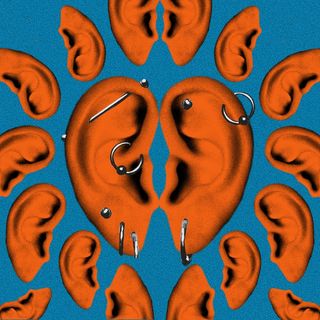
Pleasure Under Capitalism
When did sexual empowerment become sexual consumerism?
.png?rect=0,919,4000,2663&w=320&h=213&fit=min&auto=format)
In ‘Under Capitalism,’ we look at how desire, intimacy, and relationships intersect with the logic of capitalism.
On a typical scroll-through on social media, it isn’t uncommon to see pop t-shirts that enthusiastically endorse orgasms alongside feminism, social justice, and empowerment. You can get free totes that show you off as an empowered, liberated woman of the 21st century if you buy a vibrator above a certain hefty price. Pleasure brands talk empowerment, liberation, and justice – one of their stated aims is to close the “orgasm gap” for straight people.
But there’s friction between the feminism and the consumerism of it all. What does it mean to have pleasure products without pleasure politics?
A coterie of influencers, counselors, experts, life coaches and retailers are its main players; pleasure is what’s for sale. You can consume infobytes about how to stimulate genitals for free; you can then buy a toy for doing just that, at costs which remain prohibitive to most women in India save for a managerial class minority. The pleasure industrial complex is packaged in the language of sexual empowerment and liberation. And it’s changing how we experience pleasure itself.
The short of it is: a lot of sexual pleasure is commodified and controlled by the market now. But perhaps there never was an authentic sexual self that was free of the social forces that shape us. In an ethnography of early 2000s sex toy buyers’ parties, anthropologist Debra Curtis noted that “Sexual subjectivity, to borrow from Sally Alexander, is best understood as a ‘process which is always in the making, is never finished or complete’.” In other words, the arrival of the pleasure industry is merely another force to contend with – and in Curtis’ findings, many of the women purchasing the products expressed joy and vulnerability in association with them. Sex toys are changing people’s relationship with sex but is that, ultimately, a bad thing?
Yes, if pleasure is wholly taken over by the profit motive. Over time, pleasure has become more profitable than ever. By 2028, the sexual wellness industry is projected to be worth $44 billion. But herein lies the problem: sex itself, or masturbation, is free of cost. But to elevate the experience, to have good sex, there’s a price. It’s what you pay for wands, vibrators, beads, feathers, candles, lubes, whips, and plugs, all of which promise to make it better. Gadget-free sex – or pleasure – is now the less empowered, inferior kind. Pleasure products offer an upgrade to the most human experience on Earth – and in the process, they frame that experience as inherently unsatisfactory. There’s always a way to make it more satisfactory. Which, when taken to the logical conclusion of the free market, is never going to happen – because there will always be competing products, which offer better experiences, and there will always be upgrades to the one you’ve just purchased. But constantly being exhorted to buy more pleasure, scholars note, only leads to greater unfulfillment.
“To some, this represents a much-needed cultural shift that moves sexual pleasure from taboo to norm. But sex being ’normalized’ shouldn’t hinge on its economic value,” notes Beth Ashley in Face Magazine. Curtis noted further: “Clearly the distributors are peddling sexual enjoyment and fantasies. In order to do this, they capitalize on the participants’ fantasies as well as produce new ones for consumption while converting them into profit. What are the participants purchasing? Is it sex? Better sex? Confirmation of desirability?” One idea seems to be that the commodity on sale is a liberated self.
Sex toy companies have trouble circumventing strict regulations both online and offline – leaving them to resort to other marketing techniques that lean more heavily into the trending social cause of the day. But who are the intended buyers? It’s difficult to ignore the fact that sex toys are overwhelmingly marketed toward a particular type of person – post-feminist, secure, and having not just cultural and financial capital but also capital in the form of time and leisure. Indeed, with all other material comforts secured, sex remains the last frontier where many women still remain unfulfilled. Enter: pleasure products. They’re an upgrade for the Empowered Woman to become Empowered Plus. In her book Vibrator Nation, Lynn Comella writes, “sex-positive retailers double as social activists, commodities are framed as tools of liberation, and consumers are willing to pay for the promise of better living through orgasms.” They’re also overwhelmingly marketed for cis able-bodied people. Scholars have noted, for instance, the relative absence of toys oriented towards people who don’t have vulvas, people with dysphoria, and people who otherwise don’t have straight sex. Many toys assume one way of experiencing pleasure and optimize for it – to the detriment of anyone who doesn’t conform to a heteronormative, linear form of pleasure. Disability activists have long noted that mainstream sex toys exclude disabled people, leading to sex robots held up as the only alternative – a stereotype which perpetuates further alienation.
It wasn’t always like that. It’s true that sexual pleasure and agency are political, especially because oppressive puritanical norms have historically kept women from their own bodies. It was in heteropatriarchy’s interest to control and regulate women’s sexuality. Breaking free of the control is, by extension, breaking free of institutions that constrain sexuality – marriage, the family unit, and unpaid labor. And so, in the 70s in the West, sex toys used to be sold with the optimism and intentionality of treating pleasure as political. But the little shops that served as spaces for conversation, companionship, and greater sexual agency – for everyone, especially the most marginalized – needed to survive. They needed to make profits.
It’s less an individual, more a systemic problem that got us here. But it doesn’t preclude us from recognizing the problem with “here” – the total depoliticization of pleasure. We no longer think of pleasure as a right and as a factor of bodily autonomy – it’s more a lifestyle choice.
Pleasure isn’t just what you get when you buy products – framing it that way ignores the unequal sexual agency across identities. As researchers Caitlin Howlett and Quentin Wheeler-Bell write, “class restricts an individual’s performance of their sexual identity.” It’s not uniquely an Internet problem – modern sex education has turned feminist messaging about pleasure and sex into an individualized, personal issue. Influencers and sex toy brands are merely continuing on this neoliberal trajectory, wherein the goals of sexual politics are reframed as being achieved through quick, efficient orgasms.
There’s a worrying consequence to this: pleasure is now sold as empowerment to instill the notion that women “no longer need feminism to overcome oppression,” as one researcher puts it – seemingly because feminists now have the luxury of choices. Choice feminism, which posits that feminism is an endorsement of what any woman “chooses” to do on their own, paved the way for pleasure to be packaged and sold back to us as a “choice.” Making the choice to spend thousands of rupees, by extension, leads to more empowerment. All choices are equal, but some choices are more equal than others.
And this in turn turns pleasure into a quantifiable unit. How many units of pleasure can one toy impart, before you can graduate to the next one? While the word “toy” connotes play and a lack of structure, sex toys paradoxically homogenize pleasure. With the same toys, consumers can have the same kind of orgasms – faster (Here’s how Carter puts it: “Is how fast one can ‘cum’ a function of capitalist discipline?”), deeper, and more instantly gratifying than without. In regimenting how to experience “real” pleasure, the sex toy industry paradoxically erases the scope for play.
The creation of a pleasure monoculture means that everyone’s being taught how to experience pleasure using the same set variety of toys, in different shapes, colors, and textures. Pleasure capitalism displaced variety – integral to human connection – onto things. But if sexuality is relational, sexual freedom is relational too. None of us can be liberated unless all of us are. Pleasure products treat other people as secondary and only distance us from each other further.
When you really think about it, then, it’s contraception, abortion, reproductive rights, and feminist solidarity that make us freer to seek pleasure. Products are, at best, a stopgap that very few can access.
But to acknowledge the prioritization of products over emotional or interpersonal experiences would be to acknowledge that we’re increasingly being asked to prefer sex with toys rather than with people. And if it is with people, it’d better be with the toys too. “Dildos today no longer seek to approximate the physiognomy of the penis because to do so would be to run the risk of reminding the [professional managerial class] girl-boss of the tragedy of its felt absence,” writes Kasumi Borczyk, in Damage Magazine. “Instead, sex toys are trending towards looking more and more like alien life forms. Their shapes are blob-like, and their reflections are metallic. The vibrator has become helveticized.”
The aestheticization of sex toys isn’t benign. The prettier the toy, the more expensive it is, and the less it looks like anything to do with sex at all. Weirdly, the sleekness of sex toys claims to be in service of breaking moral taboos by making them look beautiful, chic, and worthy of showing off publicly without shame – they look nothing like human genitalia, but are almost aesthetic centerpieces in their own right. But the alien-like toys belie this fact, and in fact reinforce the difference between respectable, safe, appropriate, and approved sex positivity versus lascivious, gratuitous, and inappropriate sexual cultures. “There are many dildos in skin tones, but these are more often marketed towards queer men; the idea that a woman might want to fuck herself with something resembling an actual penis seems to be far less palatable. Or, possibly, far more queer,” writes Quinn Rhodes in Mashable.
This is how we realize that the sex industry pulled a fast one on us: by commodifying pleasure in the form of toys, it turned sex from a complex entanglement of physiology and feeling to one that’s increasingly physical, emotionless, and mechanical. Mechanical sex was what they initially promised to help us escape – only to have their intended consumers fall into the arms of machines instead. Sex toys are the key to having “rational” – as opposed to “emotional” (aka: messy, unoptimized) – sex.
The parts that make sex human, like feelings, awkwardness, mundanity, mutual joy, and even humour, are less valuable under pleasure capitalism – faulty symptoms of a fallible organism. But technology, which is predictable, rechargeable, and replaceable, neatly solves the problem: none of those will have to impede the intended outcome of sex, which is purely physical sensation. Masturbation is timed too; with sex toys sold as accompaniments to one’s self-care “routine.” Almost like a Protestant work ethic of pleasure. But when we lose emotions in the conversation around pleasure, we lose the things which elicit strong emotional responses and care – politics.
The tension between feminist politics and pleasure for sale is a difficult reality to contend with, given the current state of sexual inequality and harm. Pleasure products’ promise of risk-free pleasure works because it eliminates the most looming, potential threat to pleasure: another human being, who doesn’t understand us. They also promise to eliminate the burden of having to manually figure ourselves out, and offer the digital update to our analog exploration of ourselves. The problem isn’t with the toys – it’s the exhortation that we need them for true, authentic, maximized and flawless pleasure. It’s the insistence that gadgets are a necessity if, as feminists, we care about ourselves. “Sexual pleasure is a surprisingly difficult thing to locate and understand. If someone likes something or derives pleasure from it, does that mean that it should no longer be subject to interrogation or critical attention?” asked researcher Breanne Fahs. Critiquing how we’ve come to experience pleasure sounds like policing it. But it’s really the manufacturers who do the actual policing by making us feel less empowered for not buying into their products. The mushrooming of a pleasure cottage industry follows suit.
“The pop-sexologist and the sex-toy industry are co-conspirators of the same enterprise,” Borczyk continues. “The former affirms and acknowledges psycho-sexual trauma and the latter sells the tools with which she can overcome it. Purchasing vibrators, anal beads and artisanal lube become acts of resistance.”
So what, one might say to all this. Maybe purchasing sex toys is resistance for women stuck in sexually oppressive marriages, partnerships they had no say in, or otherwise lackluster sex with people they otherwise value. But the pleasure industry offers pleasure as the end in itself – by conflating individual empowerment with feminism overall, it looks like it’s changing the oppressive norms that made sex so unequal in the first place. The more money you spend on the products, the more pleasure you derive, and the freer you get, seems to be the premise – making liberation from sexual oppression or boredom contingent on how much cash you can pay for it, rather than something to be wrestled for in the streets, the courts, the public, private, and in-between. Instead, here we are: sexual empowerment seamlessly became sexual consumerism. We’re implored to use products in order to “know” and “own” our bodies and pleasure, but it begs the question: why does ownership of ourselves require ownership of things?
Rohitha Naraharisetty is a Senior Associate Editor at The Swaddle. She writes about the intersection of gender, caste, social movements, and pop culture. She can be found on Instagram at @rohitha_97 or on Twitter at @romimacaronii.
Related


Why 'Neurodiversity' and 'Neurodivergence' Shouldn't Be Used Interchangeably
